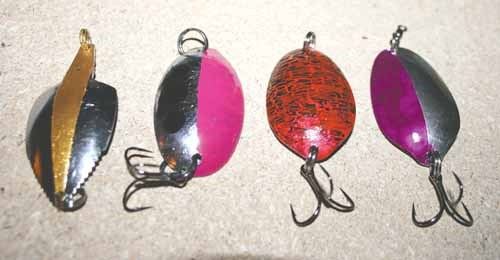It's back to the workbench for another homemade lure effort.
After the success of the bottle cap lures I was, like a hungry pike, hooked on the idea of making hooks.
But for me that means keeping it simple. I am not the 'craftiest' person around, and my tool kit is woefully lacking after a hammer and pair of pliers.
If you are regular reader, and I know many of you are, and I thank you for following along this summer, you know I am a diehard spoon tosser. So it made sense to me to try fashioning a few of my own.
This really proved to be far simpler than I had expected.
I choose to work with teaspoons, although everything it takes to make a lure from the smaller spoon transfer to a tablespoon, which I would have used had local pike just been a bit bigger on average.
The first step is acquiring spoons. Stainless steel are the way to go, and while you might think about raiding the kitchen drawer a thrift shop or yard sale is probably a safer option, at least if you are married.
Once you have a few spoons, it's time to get to work. You need a hole drilled at each end of the spoon large enough to accommodate a split ring. It should be close to the edge to make the split ring attachment easier. Grab a commercial spoon from your tackle box as a guide.
You can use a hand drill, but a drill press works slicker. Thankfully Rex Goulden was good enough to give me access to his for the task. Leave the spoon handle on until after the holes are drilled as it gives you something to hold onto.
Speaking of the handles, they too can be drilled and used as lures, giving you long, narrow ones that with a swivel attached really dance in the water.
Once the holes are drilled, use a hacksaw to cut off the handle.
The edge might be rough so a small file comes in handy. An electric grind wheel does the job quicker.
At this point you are done in terms of requiring shop skills.
Next add a split ring to each end.
Now it's painting time.
I initially considered enamel model paint, and if I had some might have opted for that.
But I didn't want to buy a bunch of model paint for a few lures that I did not know how they might work.
That was when I decided to use nail polish. It is cheap if you need to buy, and if married the Mrs. probably has some colours she is no longer interested in so you can have those.
Masking tape can be used to cover areas you don't want a colour to go. Apply the nail polish, let dry and do it again. Some colors might take more than two coats, which is not a problem since nail polish dries quick.
Next time I might lightly emery cloth the areas to paint just to enhance the bonding of the polish to the spoon a bit.
Again the Mrs. will be a good source of information and help on techniques such as 'crackling' which can give a hook a different look.
I opted for pretty simply patterns -- purple of one half, bare silver spoon on the other is one example -- and tried for colours that were different from my everyday commercial hooks. You can't beat a Len Thompson colour, so try something different.
It was also easier to get my wife's steady hand to do the nail polish application by keeping it simple.
Over the paint apply a couple of coats of clear coat.
Finally I sprayed the hooks with a mat finish clear coat. So far the hooks have stood up. In time they will chip on rocks and fish bites, but so do the best commercial hooks. At least homemade you can touch up easily.
Once the clear coats are completely dry attach a swivel to the smallest end of the spoon, and a treble hook to the split ring at the other and you have a completed lure.
In terms of look the eight lures I made -- four spoons and four handles -- the finished product looks far better than I had expected. The nail polish has a natural shine and the use of masking tape meant the edges are crisp.
They are definitely something I'll proudly show off to other fishermen.
But do they catch fish?
It's a Sunday morning and Theodore Dam is the destination for the homemade spoon trial.
The usually busy spot is eerily empty of fisherman, not a good sign even on a day farmer's are harvesting and the Saskatchewan Roughriders hit television just before noon.
I start the day with a handle lure painted red with a silver outline. It is at least in the same category with a red and white spoon which has been very effective at the dam.
It takes a few casts but a pike finally obliges. It's not huge but would have been a keeper if I was not in a catch and release mood, so it got to swim away.
That however, was it. After 90-minutes at two spots at the dam end, we head to Whitesand Regional Park down the other end of the water, and put in another 90-minutes.
No more fish. Not so much as a bite.
That would be worrisome using homemade hooks, but there were plenty of casts with popular Len Thompson spoons and lead head grubs and still nothing, so I can't blame the crafted lures.
I can say they cast well, and the movement in the water is active, so those are good points.
But as for catching fish, well Sunday wasn't a particularly good measuring stick, so I remain hopeful they'll hold their own on days fish are in the mood to bit even a little.




